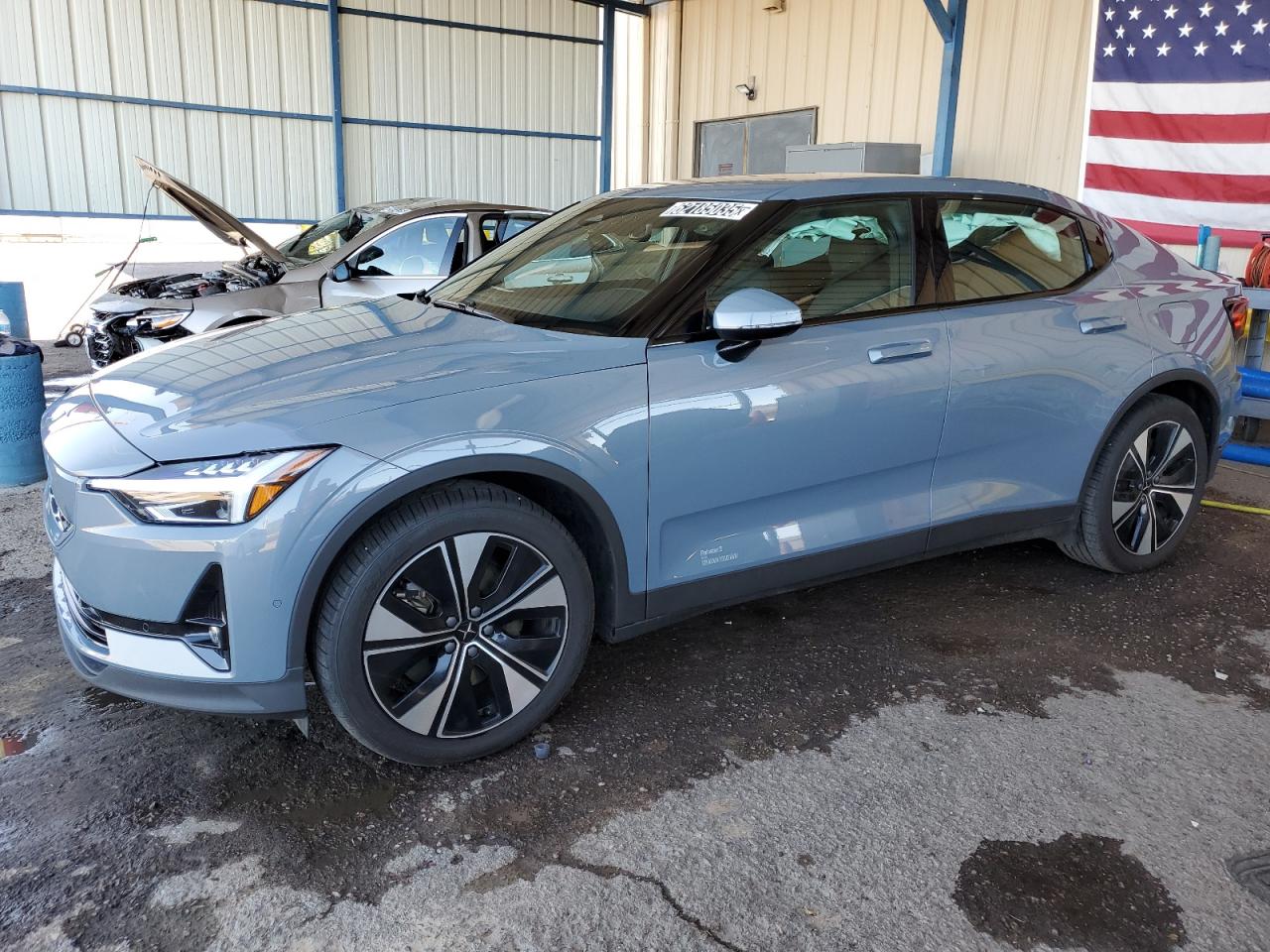2024 POLESTAR PS2 | YSMFD3KA8RL218743
Lot details
- Sale Date2025-06-05
- Lot Number41967387
- ACV38822 $
- Sale documentSalvage (Texas)
- LocationElectric Vehicle Auctions (IL)
- Odometer8,178 miles (13,161 km)
- Primary DamageRIGHT REAR
- SellerProgressive Casualty Insurance
Vehicle specifications
6
~$55,000
Engine: 1x electric motor
Torque: 680 Nm
0–100 km/h: ~4.2 s
The Polestar 2 Long Range Dual Motor with Performance Pack is not a reinterpretation of a sports sedan — it is a confident, purpose-built EV that fuses minimalist Scandinavian design with focused engineering. With 476 horsepower and 740 Nm of torque distributed across both axles, it delivers acceleration that feels immediate and linear, without noise or delay. But unlike many EVs that chase only straight-line numbers, the Performance Pack version makes driving engagement the goal, not just the byproduct. Its power isn’t overwhelming — it’s calibrated, progressive, and always under control.
Chassis tuning is the key to the Polestar 2’s dynamic identity. Öhlins manually adjustable dampers, combined with a lower stance and bespoke Pirelli tires, transform the car’s handling into something taut and reactive. Steering weight is natural and well-matched to the platform — never overly synthetic — and the chassis communicates with confidence through corners. The dual-motor setup gives it traction out of tight bends, but the torque split remains transparent, keeping the car agile rather than artificially planted. It's not trying to mask its mass; it manages it honestly through suspension tuning and brake feel, not trick electronics.
What sets the Polestar 2 apart is its restraint. It doesn’t imitate performance through gimmicks. It doesn’t shout with artificial noise or exaggerated body kits. It feels carved from a single engineering idea: to be fast, sharp, and clean in every sense. In an age where EVs often confuse drama with excitement, the Polestar 2 takes a more disciplined path — delivering composure, precision, and satisfaction for drivers who value feel over flash. It’s not about shock. It’s about substance.
Final Bid Polestar PS2 (2024)
$10,000
$12,523
$20,000
Body Styles
The Polestar 2 is offered exclusively as a 5-door fastback liftback sedan with crossover-influenced ride height and sharp Scandinavian styling. It combines the sleek profile of a gran turismo with the functionality of a hatch, providing 405 liters of cargo space plus a 35-liter front trunk. Its proportions are defined by short overhangs, high shoulder lines, and frameless door mirrors. Built on the CMA platform shared with the Volvo XC40, the Polestar 2 features a low-mounted battery pack integrated into the floor, which aids rigidity and crash safety. The 2023 refresh included a revised front grille with the SmartZone panel (housing sensors and cameras), and RWD became the new default layout.
Model Name Meaning (Manufacturer)
The name “Polestar 2” refers to the second model developed under the Polestar brand as an independent EV-focused company co-owned by Volvo and Geely. Unlike the Polestar 1, which was a hybrid GT, the Polestar 2 is a fully electric, mass-production model meant to compete directly with Tesla. The “2” designates its position in the brand’s model evolution but also reflects its role as the company’s first mainstream product, blending Volvo's safety philosophy with performance-driven electric engineering. The shift to RWD in 2023 further aligned with the brand's ambition to enhance driver dynamics and identity.
Body & Interior Colors and Rims
Exterior colors include minimalist, cool-toned finishes such as Magnesium, Snow, Space, Thunder, Jupiter, Midnight, and the Performance Pack-exclusive Gold calipers and trim details. Some special edition colors like Matte Zinc or Nebula remain rare and tied to limited runs. Paint options are kept deliberately muted to reflect Scandinavian restraint.
Inside, the Polestar 2 emphasizes sustainability and modernism, offering WeaveTech vegan upholstery, embossed textiles, or ventilated Nappa leather depending on trim. The dashboard is dominated by a 11.2” portrait touchscreen powered by native Google Android Automotive OS, complemented by a 12.3” digital instrument cluster. The interior features tactile knurled aluminum, reconstructed wood trim, or recycled materials throughout — all set in a clean, geometric layout that prioritizes calm usability.
Wheels vary from 19” standard multi-spoke alloys to optional 20” forged wheels with diamond-cut surfaces, especially in Performance variants. The rims are aerodynamically optimized, and available in matte black, gunmetal, or polished silver finishes. Gold brake calipers and seatbelts are included in the Performance Pack, providing subtle visual punch without sacrificing design harmony.
Top Expensive Options
- Performance Pack (Ohlins dampers, 20" wheels, Brembo brakes, gold details): ~$5,500
- Pilot Lite Pack (adaptive cruise, 360° camera, BLIS, Pilot Assist): ~$2,000
- Plus Pack (heat pump, panoramic roof, premium audio, WeaveTech seats): ~$4,000
- Nappa Leather Interior with Ventilated Front Seats: ~$4,500
- Harman Kardon Premium Sound System (13 speakers): ~$800
- 20" Forged Alloy Wheels with Performance Tires: ~$1,200
- Pixel LED Headlights with Cornering Function: ~$1,000
- Semi-Automated Parking Assist: ~$500
- OTA Performance Software Upgrade (adds 68 hp): ~$1,200
- Metallic or Special Exterior Paint: ~$1,200
vs Competitors
The Polestar 2 sits in a competitive field of electric sedans and liftbacks, often compared to the Tesla Model 3, BMW i4, Hyundai Ioniq 6, and Kia EV6. Against the Model 3, the Polestar 2 offers a more tactile and design-led interior, with superior material quality and a less screen-dominated experience, though it lacks Tesla’s charging infrastructure and software ecosystem fluidity.
In comparison to the BMW i4 eDrive40, the Polestar 2 rides firmer but feels more focused in corners, with quicker steering and a more playful RWD character in the latest versions. While the i4 has the edge in range and cabin quietness, the Polestar wins in UI clarity and sustainability ethos.
Against the Ioniq 6 or EV6, the Polestar feels more premium and performance-oriented, though its charging speed (up to 205 kW DC) trails the 800V Korean competitors. Nevertheless, Polestar counters with stronger brand identity, a European design narrative, and a firmer connection to traditional performance car heritage via Volvo and its tuning legacy.
Ultimately, the Polestar 2 offers one of the most balanced combinations of style, handling, interior quality, and EV range in the midsize electric segment — favoring those who appreciate restrained Scandinavian design and analog feedback over software flashiness.
Fun Fact
The Polestar 2 was the first mass-production vehicle in the world to feature Google’s Android Automotive OS as its native infotainment system, offering full Google Maps, Assistant, and Play Store integration without a smartphone connection — a pioneering move that influenced legacy automakers to follow suit.
Additionally, unlike many EV startups, the Polestar 2 was engineered and crash-tested using Volvo's decades of safety research, making it one of the safest EVs ever tested by Euro NCAP and IIHS, with a five-star rating and standout pedestrian protection scores.









